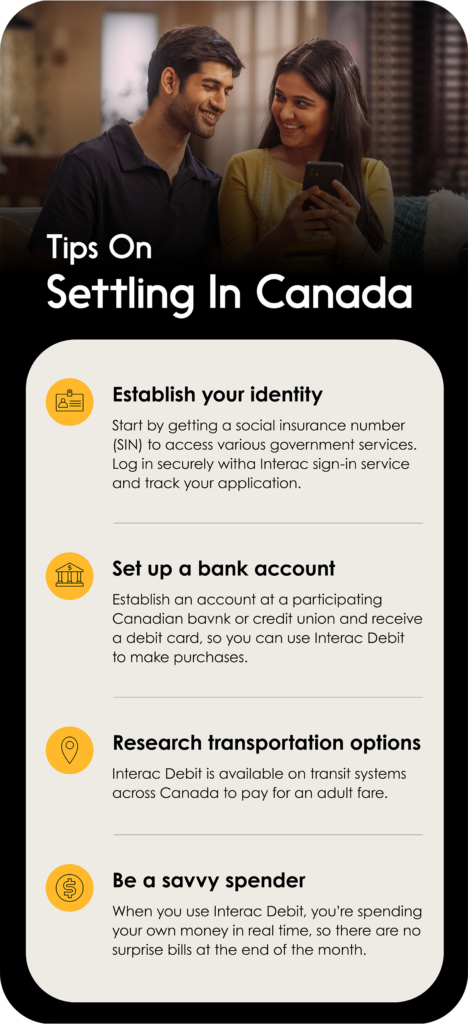Moving to a new country can be a thrilling adventure. But while it’s a time to explore new opportunities, settling in a new place also brings new challenges. For those new to Canada, the journey involves learning how to navigate various aspects of daily life, from documents and banking to housing and transportation, to dealing with Canadian winters.
It might seem overwhelming, but there are plenty of resources to help you get started and settle in smoothly and confidently.
Step 1: Establish your identity
As a new Canadian, one of your first orders of business will be getting a social insurance number (SIN). You’ll need it to access various government services.
You can track your application by logging in with Interac sign-in service, which allows you to verify your identity online using existing login credentials with a participating Canadian financial institution. It’s a simple, seamless experience that over 16 million Canadians use to access government services, and it helps to eliminate the need to create and manage new usernames and passwords. Because when you settle in a new country such as Canada, you may from time to time need to verify that you are who you say you are.
In some situations, you may be asked to verify your identity documents using Interac document verification service (for example, if you’re registering for the Canadian Revenue Agency’s (CRA) sign-in services for the first time). This is a convenient way to confirm your identity that doesn’t require sending in physical documentation or in-person visits.
Learn how Interac document verification service works here.
Speaking of the CRA, when tax season rolls around, the Canadian government’s website has a wealth of resources on navigating the tax system, including a page specifically geared to newcomers.

Step 2: Set up a bank account
Settling in a new country comes with many start-up costs. If you have questions about banking in Canada, the Canadian government has a helpful guide with details on bank accounts, debit cards, online banking, deposit insurance, and much more, including:
There’s also specific guidance on how to open a bank account and what forms of identification will be accepted. It’s important to note that if you aren’t a Canadian citizen, you will likely need to appear at the bank in person to set up your account.
Once you’ve established an account at a participating Canadian bank or credit union, you can begin using Interac Debit to make purchases. A great first step is to add it to your digital wallet on your mobile phone or device—it’s simple if you follow our step-by-step how-to guide. You will also have the option to quickly and securely send payments with Interac e-Transfer—here’s how.
It’s always a good idea to be mindful of potential fraud attempts around financial accounts and transactions. Anti-fraud authorities in Canada offer the following tips on spotting potential scams:
- Remember that law enforcement and government officials will never demand payment or threaten you with arrest by email or phone.
- Be skeptical of demands for upfront fees, including fees to be paid by prepaid credit cards, wire transfer services, cryptocurrency and gift cards.
- Don’t give out sensitive personal or financial information in response to an incoming communication, including by phone.
Step 3: Pick your phone plan
For many of us, getting a cell phone up and running might well be the first order of business. But you’ll need identification and a Canadian bank account to do it.
When it comes to choosing the phone service that’s right for you, the Canadian government provides a helpful overview of various plans and options, including detailed information on:
Step 4: Research transportation options
How you get around will depend on where you live—you might be navigating public transportation in big cities or adjusting to owning a car in more rural areas.
Interac Debit is available on participating transit systems across Canada to pay for an adult fare. This includes the Toronto Transit Commission (TTC), Vancouver’s Translink, Ontario’s GO Transit, and more. Click here to see if your local transit authority accepts Interac Debit.
If you’re commuting or travelling by train, VIA Rail will take you all over the country, from British Columbia to Nova Scotia, with plenty of stops in the provinces of Ontario and Quebec.

Step 5: Become a savvy spender
As you get settled and establish your budget, it’s important to keep track of your spending. You’ll likely have some one-time costs associated with relocating, but you’ll also be adjusting to a new set of fixed costs.
Everyday expenses:
The first step in balancing your budget is understanding and managing your daily expenses. When you use Interac Debit, you’re spending your own money in real time, so there are no surprise bills at the end of the month. You can use it for all sorts of expenses, including groceries or household supplies.
If you’re paying via an app—perhaps for your morning coffee or ordering lunch—you can set Interac Debit as the default payment method in the retailer’s app at some coffee shops, food delivery services, gas stations and clothing retailers.
Plus, newcomers can download Credit Canada’s Butterfly app, sponsored by Interac, which offers multilingual resources that help empower newcomers to take control of their finances, from budgeting basics to tips for protecting yourself against fraud and real-time currency conversion.

Costs for services:
You’ll probably be spending at least some of your budget on services— including movers, delivery services, contractors and more. Many Canadian service providers accept Interac e-Transfer as a payment method, and you can also use Interac e-Transfer to pay individuals like babysitters, tutors, house cleaners and more. Plus, adding payment details into the Interac e-Transfer memo field (“April housecleaning,” “math tutoring”) can help everyone keep track of these payments.
Sending money internationally:
Many newcomers to Canada will have family and friends—and quite possibly financial obligations—in another country. For those looking for a convenient way to send money back home, International Transfer by Mastercard and Interac is a secure and convenient way to send money to bank accounts in other countries if offered by your financial through national bank. Western Union money transfers via Interac e-Transfer also allow you to send money internationally if you bank with a participating financial institution.
Shopping for the seasons:
A word to the wise: Don’t forget to budget for Canada’s cold winters. When you’re stocking up on thermal wear, sweaters, parkas, snow boots and mittens to stay warm, Interac Debit helps you stay in charge, by using your own money, straight from your account and authorized by your financial institution in real-time at most retailers. And if you’re shopping second-hand through an online marketplace, Interac e-Transfer is a convenient, secure payment option.
Settling in a new country is a big step, but with the right resources (and a positive attitude), before you know it, you’ll feel right at home.
Use Interac e-Transfer to take the financial stress out of moving.



